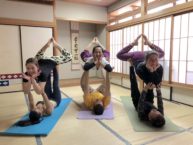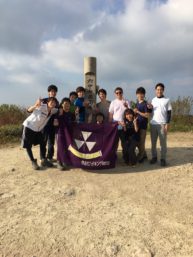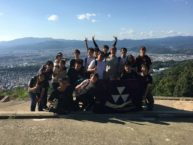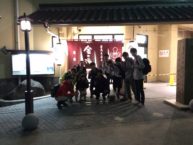For my CIP, I joined Doshisha University’s Hiking Circle and did Acro Yoga in the Kyoto/Osaka community.
Hiking Circle
I wanted to join a Doshisha club to meet students my own age, so I decided on hiking circle. The first time I went, we hiked Daimonji (a small peak in the city). It was thrilling to make small talk with other people who enjoy the outdoors in Japanese. The hiking day was fun, but most of the meetings are training (short runs along the Kamo or through the Gosho). If you are someone who likes to get outside for long day hikes, I might recommend a different CIP. Having a commitment in the middle of every Saturday can make it difficult to do other things with your weekend. That being said, the club members were warm and welcoming and are used to having foreigners join for a short time.
One thing that is different about hiking in Japan compared to the US is that trails are so accessible. I loved being able to hop on a bus and go for a short hike anytime I had the day or afternoon free. Most trails have some sort of religious significance, which was fascinating to learn about and worthwhile to experience.
Acro Yoga
I am in the circus club at JHU and have been practicing Acro Yoga for a few years, so when I found out there is a thriving acro community in the Kansai area, I was thrilled to join. In Kansai, most of the acro is in Osaka, but there is a small and growing community in Kyoto. The Kyoto community is extraordinarily warm, and has a nice mix of Japanese people and foreigners. Hearing Japanese in a class environment was exciting because I could understand the directions, and already knew the poses. The Osaka jams had more advanced acro, but also more foreigners, so I used my Japanese less. In both places, I met really lovely people who were open and eager to communicate.
The acro class environment was a great place to practice casual speech. I spoke to the teacher using です/ますform, but even though most of the participants were older than me, we were all students, so we spoke casually. Acro involves detailed communication between the flyer and the base, which is hard even in English. It is especially difficult in Japanese, where both the language and culture emphasize deferring to others. I’m grateful that I had this safe place to practice both Japanese and Acro and was able to engage with the local community doing something that I love.




